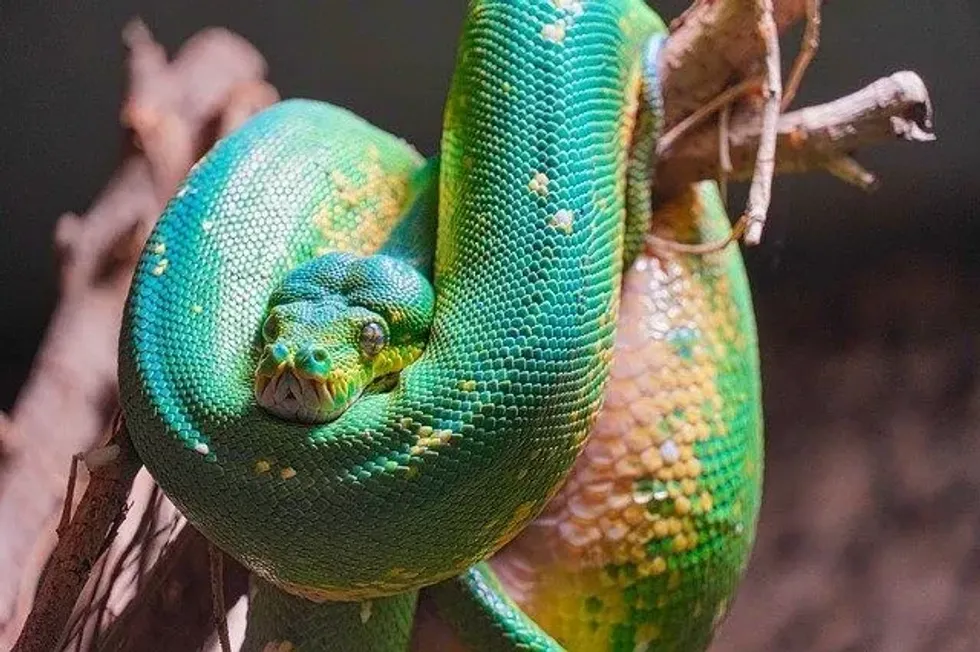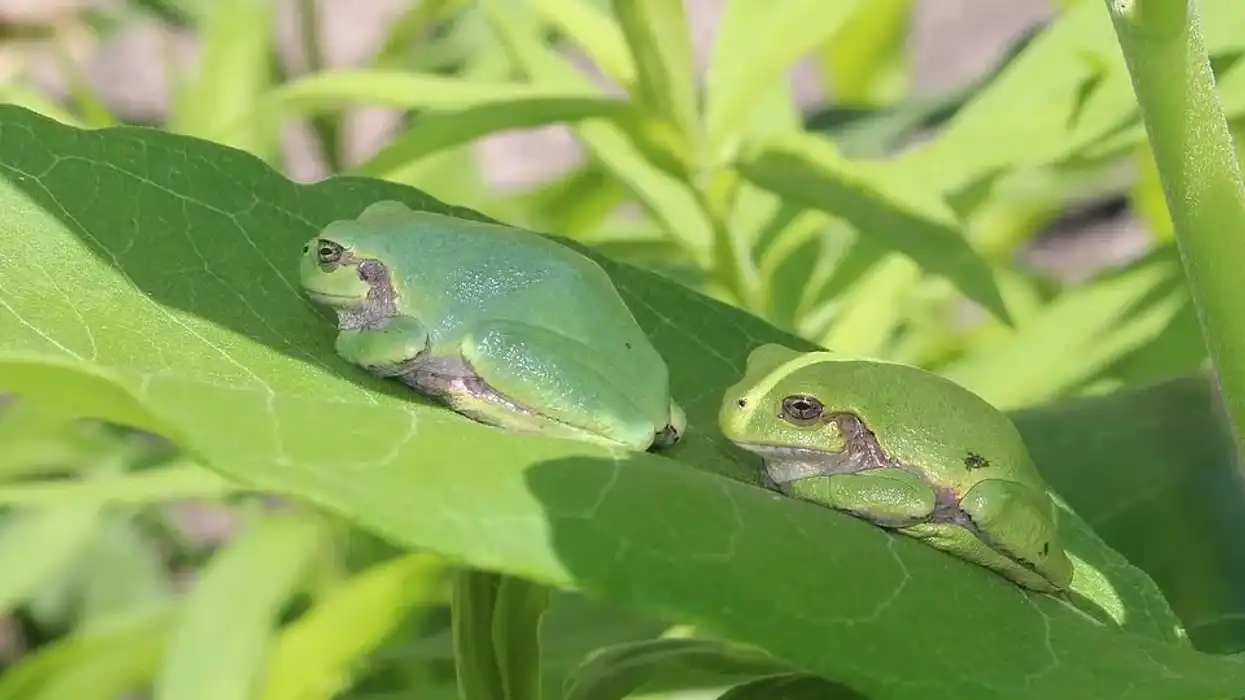The green tree python, (Morelia viridis) is a species of snake (Pythonidae) belonging to class reptilia; order squamata family. This species of snake is native to New Guinea and its surrounding islands, Eastern Indonesia, and the Cape York Peninsula of Queensland Australia.
They were earlier also known as Chondropython viridis. As the name suggests they are bright green in color.
Green tree pythons are carnivorous in nature as they mainly hunt for tree lizards, birds, and small mammals. It is considered to be a popular pet due to its unique non-venomous nature.
They rest in a peculiar way through tree branches as they coil themselves over two or more branches and position their head in the middle which is similar to another snake, the emerald tree boa. The yellow-green tree python is basically a newborn that changes its color after 6-12 months.
After breeding, females hatch and incubate the eggs but there is no show of any parental behavior post-hatching. Although, the albino green tree python is the most easily available python in pet stores.
If you liked these true facts about green tree python, then you'll surely like these facts about cottonmouth snake and copperhead snake too!
Green Tree Python Interesting Facts
What type of animal is a green tree python?
Green tree pythons are native to New Guinea and its neighboring islands, Indonesia, and the Cape York Peninsula in Australia. Their main habitat is tropical rainforests. They are primary arboreal, living in tree branches and shrubs. Green tree pythons have an average life span of 15 years.
Green tree pythons, (Morelia viridis) are very slow compared to other species of Pythons since they do not need to move much to capture their prey. They wait for their prey with extreme patience and become almost invisible because of their color. The blue-green tree python is extremely rare and some of the newborns carry the blue color.
What class of animal does a green tree python belong to?
Green tree python (Morelia Vidiris) belongs to the genus Morelia, reptilia family; reptiles are tetrapod vertebrates, basically creatures that have either four limbs or like snakes, have four-limbed ancestors.
Most reptiles are oviparous (producing young by means of eggs which are hatched after they have been laid by the parent, as with birds.). Reptile eggs are surrounded by membrane for protection and transport, adapting them to reproduction on dry land. The reptile class comprises tortoises, turtles, snakes, lizards, crocodilians, and other relatives.
How many green tree pythons are there in the world?
Currently, there is no accurate data available on the python green tree population.
Where does a green tree python live?
They are natives of New Guinea and its surrounding islands, Eastern Indonesia, Queensland Australia.
What is a green tree python's habitat?
Green tree python prefers tropical rainforests with higher humidity, vast and thick vegetation, and they are arboreals and reside in trees, shrubs, and bushes.
Who do green tree pythons live with?
Green tree pythons are arboreal and lead a solitary life, only coming in contact with others during mating season as adults.
How long does a green tree python live?
The green tree python (Morelia viridis) has an average life span of 15 years in the wild and 20 years in captivity, in places such as zoos and other nature reserves.
This particular species of snake does not need frequent feeding, and it is known to be patient enough to wait for its catch in the same spot for almost 14 days.
How do they reproduce?
Breeding has not been reported on in the wild, but in captivity a female python lays between 5-30 eggs. After laying eggs, females wrap themselves around the eggs and incubate them. Males do not maintain a stable home range, they stop feeding when searching for females. These snakes reach their sexual maturity after three years.
What is their conservation status?
The IUCN Red List categorizes the green tree python as a species of Least Concern since they can be found over a large range of habitat and there are only isolated cases of decline due to smuggling. However, the threat from smuggling for the pet trade was recognized and requires monitoring.
Green Tree Python Fun Facts
What do green tree pythons look like?

The green tree python is named for their lively color, they have a diamond-shaped head with irregular scales, newborns are not hatched green but are born with different colors ranging between yellow, brown, red, black and blue.
Females are slightly heavier and larger than males, and males are slimmer than females. The prehensile tail helps the young snake to lure their prey and also helps them to hang from branches.
How cute are they?
Newborns are extremely cute as they are born with different colors which only adds to the cuteness factor! They are non-venomous in nature but that does not mean they like to be touched. The green tree python bite is still a painful experience, although not deadly.
How do they communicate?
The communication of green tree pythons is interspecific. These snakes use their labial pit and their eyesight to search for prey. In search of potential mates, these green tree pythons use chemical pheromones over visual cues to communicate.
How big is a green tree python?
The green tree python size varies depending on factors like their diet and other nutritional aspects. They can grow a maximum of 78.74 in (200 cm)!
How fast can a green tree python move?
Green tree pythons are extremely slow in nature. They can move about 1 mph (1.6 kph) on open ground.
How much does a green tree python weigh?
A fully grown male adult weighs between 3.1-3.5 lb (1.4-1.6 kg) whereas females are slightly larger and heavier than males.
What are their male and female names of the species?
No specific name has been assigned to either gender.
What would you call a baby green tree python?
Baby snakes have a variety of names. Some of which are snakelet, neonate, and a hatchling snake.
What do they eat?
Green tree python is similar to other species of snakes and the green tree python diet comprises of smaller animals, tree lizards, and birds.
Are they aggressive?
Yes, the green tree python is temperamental and very aggressive in nature. But they are non-venomous, so to overpower their prey they have few unique and successful hunting skills. Though they are very slow in nature they are quite aggressive when disturbed. The green tree python temperament can be quite agitated.
Would they make a good pet?
Newborn green tree python colors vary from yellow, brown, red which is pleasing to the eye. However, they are known for being aggressive, so green tree python handling is difficult. They are exotic, display animals and easy to care for.
A green tree python enclosure or habitat should be big enough for your green tree python pet to be comfortable in. Care for these pythons are best suited to intermediate-advanced keepers and they are mostly kept for their beauty and majestic nature.
Did you know...
Green tree pythons are not green when they hatch! Newly hatched green tree pythons have a bright yellow, brick red, or orange color which develops and changes to green after 6-12 months.
Adults have yellow eyes whereas newborns have white eyes. Green tree pythons are perfect examples of parallel evolution along with their close South American kin emerald tree boa, with which they are similar only in resemblance and behavior.
Green tree python fangs are long and sharp as they are arboreal species.
Jayapura green tree python can present themselves in a wide variety of physical compositions common to Morelia Azurea.
Green tree python morphs are the result of cross-breeding different varieties of snakes. Breeding in wild is very rare because it is difficult for a male to search for females, they stop feeding while searching for females.
How do green tree pythons track warm-blooded prey?
Green tree pythons are aggressive hunters and use thermal sensory pits (heat sensors) on their jaw to track warm-blooded prey.
How do green tree pythons kill their prey?
Green tree pythons have an efficient digestive system and they do not require frequent feeding, so they ambush their prey while waiting. Green tree pythons often do not move from their spot and use the same spot for almost 14 days. With the help of their prehensile tail, they can hang from the branches.
Green tree python snakelets use the tip of the tails to lure small animals. They use their sight to search for prey and then identify the prey's heat signature using their labia pits.
The green tree python bites the prey with their strong front teeth if and when the prey gets close enough to them. As newborns, they are majorly active during day time and hunt small animals.
Here at Kidadl, we have carefully created lots of interesting family-friendly animal facts for everyone to discover! Learn more about some other reptiles including corn snake, or coral snake.
You can even occupy yourself at home by drawing one on our Green tree python coloring pages.









